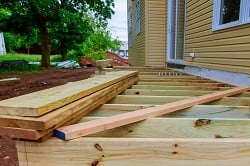
Summer is in full swing and potential customers are calling to get their outdoor spaces updated. Most will be aware that composite decking is a lasting option, but also that the upfront investment will be significantly higher. How can you help them do a cost benefit analysis of when they should repair their wood deck or tear it out and start over? Here are some points to help you and your clients.
Statistics:
- There are more than 40 million decks in the U.S. that are over 20 years old. The number of injuries and deaths related to deck failures continues to increase year after year. (North American Deck and Railing Association)
- On average, a pressure-treated wood deck will cost between $15-$25 per square foot installed, and last 10-15 years. Wood decking requires annual maintenance to keep it in good condition - cleaning, sanding, re-staining, and resealing can take days. It is estimated that the cost for maintaining a wood deck over a 10-year period could cost upwards of $5,000. (Consumer Reports)
- A composite deck will cost $30-$35 per square foot, lasting 25-30 years. Composite decking requires an annual wash that can take only a few hours. The cost for maintaining a composite deck is estimated at less than $50 per year.
Deck Warning Signs and What They Imply:
- The age of the deck: If the deck is over 15 years old, it’s time to replace it. Over that period, ledger board attachments have weakened, 4x4 support posts have experienced rot, and the overall soundness of the structure is questionable. Also, there are constant changes in building code requirements, especially in bracket and reinforcement techniques, that likely mean your deck is no longer up to code.
- Visible rot and damage to the deck boards: This is not an automatic reason to replace an entire deck, but it will give you a great opportunity to see what’s happening under the boards, in which case it may become apparent which route you need to go.
- Post(s) need replacement: This isn’t a clear sign either. Sometimes, a few posts can be far more affordable to replace than a total rebuild. The exception to that is when the posts are in-ground. Buried posts tend to rot much quicker than above ground ones. If the deck is 10+ years old, this is a strong argument for a new deck.
- Support beams are showing damage/rot: Beam replacement is a big job, one that requires replacement of large sections of a deck. It may be more practical to replace the deck entirely in this situation.
- Fascia board issues: Although this piece is more decorative than functional, if water is getting trapped behind it the entire length of the beam is is often affected and, as earlier mentioned, beam replacement is a big issue.
- Hardware is showing red rust: Corrosion in fasteners can happen at any time and is not in itself an argument for replacement of the deck, just replacement of fasteners as needed. We recommend using fasteners with corrosion-resistant finish, like SCRAIL® fasteners with FasCoat®. The exception here is if the fasteners are also causing deterioration in the surrounding wood, then those little rust spots could mean big problems.
Repair or Replace?
The ideal situation here is to help a customer identify when the cost of repairs gets too close to the cost of replacing the whole thing. Even if some structures seem sound at the time, if they’re past a certain age, you may need to replace them within a few years and that needs to be considered. Composite decking can be a steep bill upfront, but over time, it’s generally well worth the investment. Download Materials, Fasteners, Tools for Composite Deck Whitepaper below.
.svg.png)

